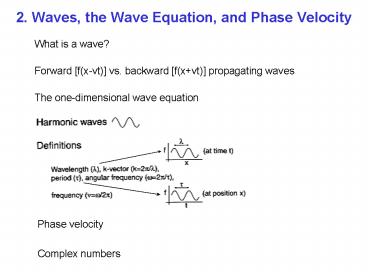2' Waves, the Wave Equation, and Phase Velocity - PowerPoint PPT Presentation
1 / 20
Title:
2' Waves, the Wave Equation, and Phase Velocity
Description:
A simpler equation for a harmonic wave: E(x,t) = A cos([kx wt] q) ... Life will get even simpler in a few minutes! Definitions: Amplitude and Absolute phase ... – PowerPoint PPT presentation
Number of Views:414
Avg rating:3.0/5.0
Title: 2' Waves, the Wave Equation, and Phase Velocity
1
2. Waves, the Wave Equation, and Phase Velocity
- What is a wave?
- Forward f(x-vt) vs. backward f(xvt)
propagating waves - The one-dimensional wave equation
Phase velocity Complex numbers
2
What is a wave?
- A wave is anything that moves.
- To displace any function f(x)
- to the right, just change its
- argument from x to x-a,
- where a is a positive number.
- If we let a v t, where v is positive
- and t is time, then the displacement
- will increase with time.
- So f(x-vt) represents a rightward, or forward,
- propagating wave.
- Similarly, f(xvt) represents a leftward, or
backward, - propagating wave.
- v will be the velocity of the wave.
3
The one-dimensional wave equation
has the simple solution
- where f(u) can be any twice-differentiable
function.
4
Proof that f(xvt) solves the wave equation
- 1. Write f(xvt) as f(u), where uxvt. So
and - 2. Now, use the chain rule
- 3. So Þ
and Þ - 4. Substituting into the wave equation
QED
5
The 1D wave equation for light waves
- Well use cosine- and sine-wave solutions
- or
- where
6
A simpler equation for a harmonic wave
- E(x,t) A cos(kx wt q)
- Use the trigonometric identity
- cos(uv) cos(u)cos(v) sin(u)sin(v)
- to obtain
- E(x,t) A cos(kx wt) cos(q) A sin(kx
wt) sin(q) - which is the same result as before, as long as
- A cos(q) B and
A sin(q) C - Life will get even simpler in a few minutes!
7
Definitions Amplitude and Absolute phase
- E(x,t) A cos(kx wt q)
- A Amplitude
- q Absolute phase (or initial phase)
8
Definitions
- Spatial quantities
Temporal quantities
9
The Phase Velocity
- How fast is the wave traveling? Velocity is a
reference distance - divided by a reference time.
The phase velocity is the wavelength /
period v l / t In terms of the
k-vector, k 2p/ l, and the angular frequency,
w 2p/ t, this is v w / k
10
The Phase of a Wave
- The phase is everything inside the cosine.
- E(t) A cos(j), where j
kx wt q - We give the phase a special name because it comes
up so often. - In terms of the phase,
- w j/t
- k j/x
- and
- j/t
- v
- j/x
11
Electromagnetism is linear The principle of
Superposition holds.
- If E1(x,t) and E2(x,t) are solutions to Maxwells
equations, - then E1(x,t) E2(x,t) is also a solution.
- Proof and
- Typically, one sine wave plus another equals a
sine wave. - This means that light beams can pass through each
other. - It also means that waves can constructively or
destructively interfere.
12
Complex numbers
Consider a point, P (x,y), on a 2D Cartesian
grid.
Let the x-coordinate be the real part and the
y-coordinate the imaginary part of a complex
number.
- So, instead of using an ordered pair, (x,y), we
write - P x i y
- A cos(j) i A sin(j)
- where i (-1)1/2
13
Euler's Formula
- exp(ij) cos(j)
i sin(j) - so the point, P A cos(j) i A sin(j), can be
- written
- P A exp(ij)
- where
- A Amplitude
- j Phase
14
Proof of Euler's Formula
- exp(ij) cos(j) i
sin(j) - Using Taylor Series
15
Complex number theorems
16
More complex number theorems
- 1. Any complex number, z, can be written
- z Re z i Im z
- So
- Re z 1/2 ( z z )
- and
- Im z 1/2i ( z z )
- where z is the complex conjugate of z ( i
i ) - 2. The "magnitude," z, of a complex number is
- z2 z z
- 3. To convert z into polar form, A exp(ij)
- A2 Re z 2 Im z 2
- tan(j) Im z / Re z
17
We can also differentiate exp(ikx) as if the
argument were real.
18
Waves using complex numbers
- The electric field of a light wave can be
written - E(x,t) A cos(kx wt q)
- Since exp(ij) cos(j) i sin(j), E(x,t) can
also be written - E(x,t) Re A expi(kx wt q)
- or
- E(x,t) 1/2 A expi(kx wt q) c.c.
- where " c.c." means "plus the complex
- conjugate of everything before the plus sign."
19
The 3D wave equation for the electric field
- or
- which has the solution
- where
- and
20
Waves using complex amplitudes
- We can let the amplitude be complex
- where we've separated out the constant stuff from
the rapidly changing stuff. - The resulting "complex amplitude" is
- So
- How do you know if E0 is real or complex?
- Sometimes people use the "", but not always.
- So always assume it's complex.































